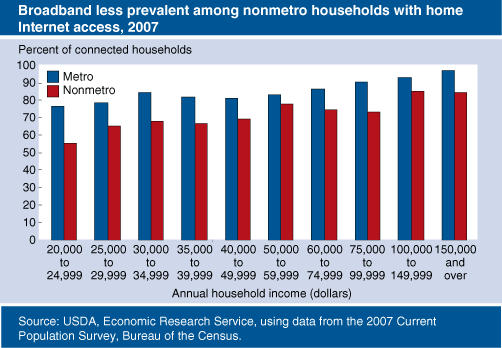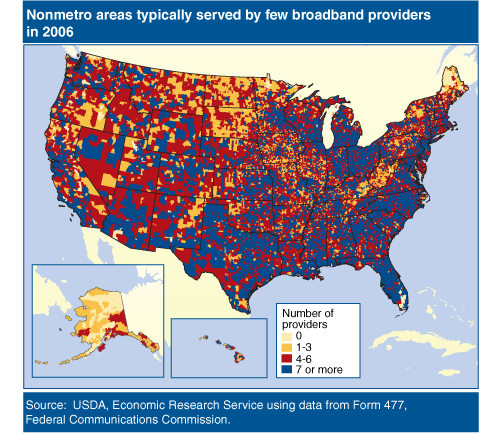Broadband Internet Service Helping Create a Rural Digital Economy
- by Peter L. Stenberg, Mitch Morehart and John Cromartie
- 9/1/2009
Highlights
- Broadband—high speed Internet—is less commonly used in rural than urban settings due to higher provision costs and more limited availability in rural areas.
- Rural counties with broadband Internet service in 2000 had greater subsequent employment and income growth than similar rural counties without service.
- Rural citizens, businesses, and communities credit broadband Internet use with providing social and economic benefits.
During the past two decades, the Internet has grown rapidly, joining telephones, televisions, and cars as a common necessity and becoming an integral part of the economy. Rural America has shared in the growth of the Internet economy as more business, government, and personal activities have gone online. In 2007, 71 percent of the rural population used the Internet, and 55 percent of farms reported using the Internet for business purposes.
As the Internet economy has evolved, more online applications require higher data transmission rates. The low transmission capability and speed of dial-up Internet service severely limit access to content-dense applications and websites. As a result, broadband Internet access has become a necessity for those wishing to benefit from the Internet’s full economic potential.
An ERS study found that investment in rural broadband Internet access seems to lead to a more competitive rural economy and rural economic growth, helping create a rural digital economy. Comparing the economic growth of counties with broadband access in 2000 with that of otherwise similar counties without broadband suggests that broadband availability helped spur the formation of new businesses and increased the growth of existing firms.
Rural Broadband Use Lags Urban Areas
By 2007, most households (82 percent) with in-home Internet access had a broadband connection. A marked difference exists, however, between urban and rural broadband use—only 70 percent of rural households with in-home Internet access had a broadband connection in 2007, compared with 84 percent of urban households. The rural-urban difference in in-home broadband adoption among households with similar income levels reflects the more limited availability of broadband in rural settings.
Areas with low population size, locations that have experienced persistent population loss and an aging population, or places where population is widely dispersed over demanding terrain generally have difficulty attracting broadband service providers. These characteristics can make the fixed cost of providing broadband access too high, or limit potential demand, thus depressing the profitability of providing service. Clusters of lower service exist in sparsely populated areas, such as the Dakotas, eastern Montana, northern Minnesota, and eastern Oregon. Other low-service areas, such as the Missouri-Iowa border and Appalachia, have aging and declining numbers of residents.
Broadband Availability May Impact Rural Economic Growth
Measuring the economic effects of limited broadband availability on rural areas is challenging. Broadband has not been available for long, and its use has grown rapidly, making it difficult to separate broadband’s effect from other causes of economic growth. To examine the effect that broadband availability has had on rural areas, ERS researchers compared a group of rural counties that had broadband by 2000 with a group of otherwise similar rural counties that did not. Rural counties with and without broadband service were paired based on having similar population size and density, industrial composition, employment growth, and income characteristics. In particular, the two county groups exhibited nearly identical average nonfarm employment and private nonfarm earnings growth in the 10 years prior to 2000.
A comparison of post-2000 economic trends in these two sets of rural counties found results that are consistent with the argument that broadband Internet availability had positive effects on the economic vitality of rural areas. The average number of both nonfarm proprietors and nonfarm jobs grew faster in counties that had broadband service available by 2000. The advantage grew early on but decreased as other communities started to gain greater broadband access. Broadband availability may have encouraged the formation of new businesses and contributed to the retention and growth of pre-existing businesses.
Wage and salary income and nonfarm proprietor’s income were also higher in counties that had earlier broadband availability. As time went on, and the other counties gained broadband access, the difference in income growth diminished. The initial larger gains in income relative to employment suggest greater increases in higher paying jobs or in productivity in counties with early broadband availability. These findings may be a sign that early investment in rural broadband Internet led to a more competitive rural economy through increased rural business efficiencies, improved consumer and government services, and expanded economic opportunities.
Broadband Expands Options for Rural Residents and Businesses
Previous research sheds light on why broadband Internet access might have wide-ranging economic effects and improve the well-being of rural communities. Evidence suggests that the widespread availability of broadband Internet access can enhance community interaction, improve access to health and educational services, increase household income prospects through telework activities, and provide rural businesses with access to broader markets for their goods.
Telemedicine and telehealth practices in rural clinics and hospitals have led to improvements in the well-being of rural individuals and communities. Specialist services are offered in real-time to clinics with no onsite full-time specialist (see “Taking the Pulse of Rural Health Care”). Patients do not always have to travel long distances or wait days to consult with specialists. It also may not always be necessary to evacuate emergency cases to a larger hospital. Patient savings ranged from $2,000 to $110,000 per year for 24 rural hospitals included in an ERS-sponsored study of Southern Plains States telemedicine practices. Telemedicine may improve the perception of locally provided health care quality, offer a larger menu of medical services than otherwise would be provided, and aid in treating emergencies more effectively.
Telework opportunities can make rural locations, particularly those with broadband service, attractive to those interested in urban-based jobs and a rural lifestyle. Some businesses have expressed interest in locating more of their jobs in rural areas instead of outsourcing them overseas. In a recent study, 37 percent of rural residents surveyed were very interested in working from home to earn additional income, and an additional 39 percent were moderately or somewhat interested.
Business adoption of the Internet has been rapid. Many farm businesses purchase inputs and make sales online, potentially reducing operating costs and increasing profit margins. As Internet adoption expands and online purchasing and marketing become more the norm, the need for high-speed Internet also increases. Rural businesses do not use broadband as much as urban businesses, but those that do argue that broadband use improves their economic vitality. Preliminary research suggests that rural business use of broadband lags, in part, due to higher rural prices and limited availability.
Wholesalers often require rural retailers to use the Internet as they rapidly adopt Internet business-to-business practices that reduce labor, capital, and inventory costs. Rural retail business Internet users also report that broadband access enabled them to increase operational effectiveness by allowing such activities as online reordering. With broadband access, rural businesses also can exploit market niches by creating an online presence. The Internet, however, has also increased the competition rural businesses face. For example, banks may no longer be local in nature as customers increasingly conduct their banking business online.
Recent Policy Developments Could Expand Rural Broadband
The Internet has become much more integrated into the rural economy as consumers, businesses, and government have increased online activities. Broadband Internet access, however, is not as readily available in rural settings.
Government policies that encourage deployment of broadband services have increased their availability in rural America. The Universal Service Program established by the 1996 Telecommunications Act funded broadband Internet access for medical facilities and elementary and secondary schools. The 2008 Farm Act (Food, Conservation, and Energy Act of 2008) reauthorized USDA’s telemedicine and distance learning and rural broadband access grant and loan programs. The American Recovery and Reinvestment Act of 2009 provided $2.5 billion to USDA for loans and grants to increase broadband provision in rural areas. If these funds address the needs of unserved and underserved communities, rural broadband availability will continue to spread in the future.
This article is drawn from:
- Morehart, M., Vogel, S., Cromartie, J., Breneman, V. & Brown, D. (2009). Broadband Internet's Value for Rural America. U.S. Department of Agriculture, Economic Research Service. ERR-78.
- Briefing Room on the Rural Digital Economy (archived). (2010). Economic Research Service.
You may also like:
- Low, S.A. (2009). Rural Broadband At A Glance, 2009 Edition. U.S. Department of Agriculture, Economic Research Service. EIB-47.




